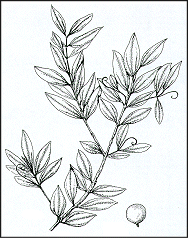CURARE - STRYCHNOS GUIANENSIS.
 Common name Common name
Curare, urali, urari, duru duru, anzuelo casha.
Family
Loganiaceae, Strychnine.
Overview
Curare (Strychnos guianens) is a common vine (liana) with a rough, brown bark from the Amazon rainforest.
The stem and root are used to make curare (a mixture).
The poison from the roots and stem of this plant is the main ingredient in pot curare (calabash curare).
Curare inhibits the action of the enzyme cholinesterase, resulting muscular and respiratory paralysis.
It only works in the blood and the heart is not affected by the strychnos guianensis.
An other poison in the curare mixture, spigelia anthelmia, raises the heartbeat to a very rapid beat until it stops due to this.
The liana is advancing with the help of hooks at the young tops of the plant.
The very short leaves stand in pairs attached to the round, rusty-brown hairy twigs.
The leaves are up to 3" long and leathery ovalate. The upside of the leave is shiny. The flowers are white and aromatic. The fruit is a yellow berry.
Many plant materials are used in addition to the strychnos to complete the poison curare, such as chondrodendron tomentosum and spigelia anthelmia.
The Amerindians use the curare as an arrow poison.
When introduced by penetration of the arrow, curare paralyzes the muscle fibers of the heart and the motor nerve endings in voluntary muscles; this causes usually the death of the victim.
Medicinal applications
The alkaloïd tubocurarine is extracted and when given in small quantities (together with general anesthesia) relaxes the muscle tissue and lessens the possibility of anesthesia-induced complications; also used for acute arthritis and muscle trauma.
Suriname's Traditional Medicine
Duru duru is used as an aphrodisiac.
Visit also our CHOLESTEROL -, DIABETES - , HYPERTENSION - , TINCTURE pages.
Hardiness
USDA zone 10 - 11.
Propagation
Seeds.
Culture
Partial sun, moist soil.
Needs high humidity. |


 Common name
Common name